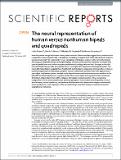| dc.contributor.author | Papeo, Liuba | en_US |
| dc.contributor.author | Wurm, Moritz F. | en_US |
| dc.contributor.author | Oosterhof, Nikolaas N. | en_US |
| dc.contributor.author | Caramazza, Alfonso | en_US |
| dc.date.accessioned | 2017-12-06T05:57:36Z | |
| dc.date.issued | 2017 | en_US |
| dc.identifier.citation | Papeo, Liuba, Moritz F. Wurm, Nikolaas N. Oosterhof, and Alfonso Caramazza. 2017. “The neural representation of human versus nonhuman bipeds and quadrupeds.” Scientific Reports 7 (1): 14040. doi:10.1038/s41598-017-14424-7. http://dx.doi.org/10.1038/s41598-017-14424-7. | en |
| dc.identifier.issn | | en |
| dc.identifier.uri | http://nrs.harvard.edu/urn-3:HUL.InstRepos:34492493 | |
| dc.description.abstract | How do humans recognize humans among other creatures? Recent studies suggest that a preference for conspecifics may emerge already in perceptual processing, in regions such as the right posterior superior temporal sulcus (pSTS), implicated in visual perception of biological motion. In the current functional MRI study, participants viewed point-light displays of human and nonhuman creatures moving in their typical bipedal (man and chicken) or quadrupedal mode (crawling-baby and cat). Stronger activity for man and chicken versus baby and cat was found in the right pSTS responsive to biological motion. The novel effect of pedalism suggests that, if right pSTS contributes to recognizing of conspecifics, it does so by detecting perceptual features (e.g. bipedal motion) that reliably correlate with their appearance. A searchlight multivariate pattern analysis could decode humans and nonhumans across pedalism in the left pSTS and bilateral posterior cingulate cortex. This result implies a categorical human-nonhuman distinction, independent from within-category physical/perceptual variation. Thus, recognizing conspecifics involves visual classification based on perceptual features that most frequently co-occur with humans, such as bipedalism, and retrieval of information that determines category membership above and beyond visual appearance. The current findings show that these processes are at work in separate brain networks. | en |
| dc.language.iso | en_US | en |
| dc.publisher | Nature Publishing Group UK | en |
| dc.relation.isversionof | doi:10.1038/s41598-017-14424-7 | en |
| dc.relation.hasversion | http://www.ncbi.nlm.nih.gov/pmc/articles/PMC5656636/pdf/ | en |
| dash.license | LAA | en_US |
| dc.title | The neural representation of human versus nonhuman bipeds and quadrupeds | en |
| dc.type | Journal Article | en_US |
| dc.description.version | Version of Record | en |
| dc.relation.journal | Scientific Reports | en |
| dash.depositing.author | Caramazza, Alfonso | en_US |
| dc.date.available | 2017-12-06T05:57:36Z | |
| dc.identifier.doi | 10.1038/s41598-017-14424-7 | * |
| dash.contributor.affiliated | Caramazza, Alfonso | |


